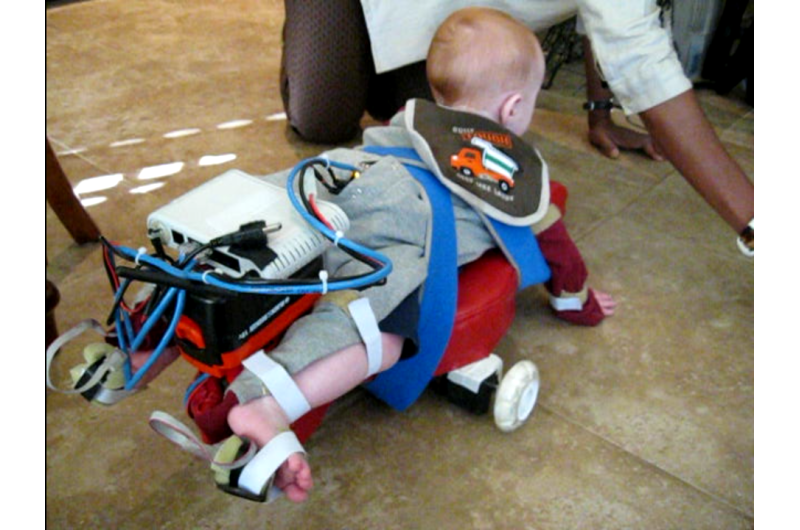(Tech Xplore)—Children at risk of cerebral palsy may get help for crawling and walking thanks to a robot assistant, in the form of a motorized device worn by the baby.
Four researchers, Andrew Fagg, Lei Ding, Thubi Kolobe, and David Miller report on their development, with its potential to reduce functional limitations and potential deficits in cognitive development.
If a young baby shows no signs of successful crawling, there are considerable risks at play. Spontaneous limb and trunk movements are the developmental agents that enable infants to start crawling, said the researchers. Without this positive feedback, troubling results follow. They said, "the development of the neural pathways for productive limb use is diminished, which results in delayed or lack of development of crawling and walking."
Consider, on the other hand, the developmental advantages in being able to scurry across the floor:
"The rewarding locomotory experience drives the infant to refine the movements to intentional and exploratory skills. Ultimately, the infant intentionally engages these skills to solve larger problems, such as obtaining an interesting toy or exploring their environment. Infants with conditions such as CP lack the muscle strength, postural control, and motor coordination necessary for these early exploratory limb and trunk movements to result in locomotion."
Cheyenne Macdonald wrote in Daily Mail that Cerebral palsy is typically diagnosed around the time a child reaches his or her first birthday, and affects movement and muscle coordination; many infants with cerebral palsy are unable to crawl until about the age of 2, if at all.
According to the Centers for Disease Control and Prevention, "Cerebral palsy is the most common motor disability in childhood, and these children need support." The CDC said that from birth to 5 years, a child should reach movement goals— milestones—such as rolling over, sitting up, standing, and walking. A delay in reaching the movement milestones could be a sign of CP.
Megan Scudellari in IEEE Spectrum discussed the work that these researchers are doing. It's a team of biomedical engineers and physical therapists at the University of Oklahoma. The team is doing a trial of 56 infants, and the trial is funded by the National Science Foundation's National Robotics Initiative. They are looking at ages between 4 and 8 months. The infants are strapped into the special outfits.
The device is called the Self-Initiated Prone Progression Crawler, or SIPPC. Elements. Scudellari said there is a soft pad that rolls along on wheels along with the "sensor-studded outfit." The cap is "dotted with dozens of small, EEG electrodes for detecting real-time brain activity as the infants navigate."
Cameras mounted on the SIPPC capture what each of the infant's limbs is doing at a given time.
Scudellari described what happens when the suit is on the infant: If the baby attempts to push off with back feet but lacks the force to move, "the robot would helpfully zip her a few inches ahead. If she moved an arm as if to push to the side, the robot could almost simultaneously turn her in that direction."
Each session produces about 10 gigabytes of data. The study has another 6 to 9 months to go. So far, the results seem to align with the earlier pilot results, said IEEE Spectrum.
What's next for this team? It would be necessary to do "a much larger-scale study with researchers at several universities," said Andrew Fagg, an engineering professor, in IEEE Spectrum. "In the long run, we'd like to be there, but we need to do the science first."
More information:
www-symbiotic.cs.ou.edu/projects/cerebral_palsy/
spectrum.ieee.org/the-human-os … k-for-cerebral-palsy
© 2016 Tech Xplore






















